Page 226 of 352
224
Checks
Blue HDi Diesel engines
The various caps and covers allow access for checking the levels of the various fluids, for replacing certain components and for priming the fuel system.
1. Power steering reservoir. 2. Screenwash and headlamp wash reservoir. 3. Coolant header tank. 4. Brake fluid reservoir. 5. Battery / Fuses. 6. Fusebox. 7. Air filter. 8. Engine oil dipstick. 9. Engine oil filler cap.
2.0 litre Blue HDi 150 hp2.0 litre Blue HDi 180 hp
Page 232 of 352
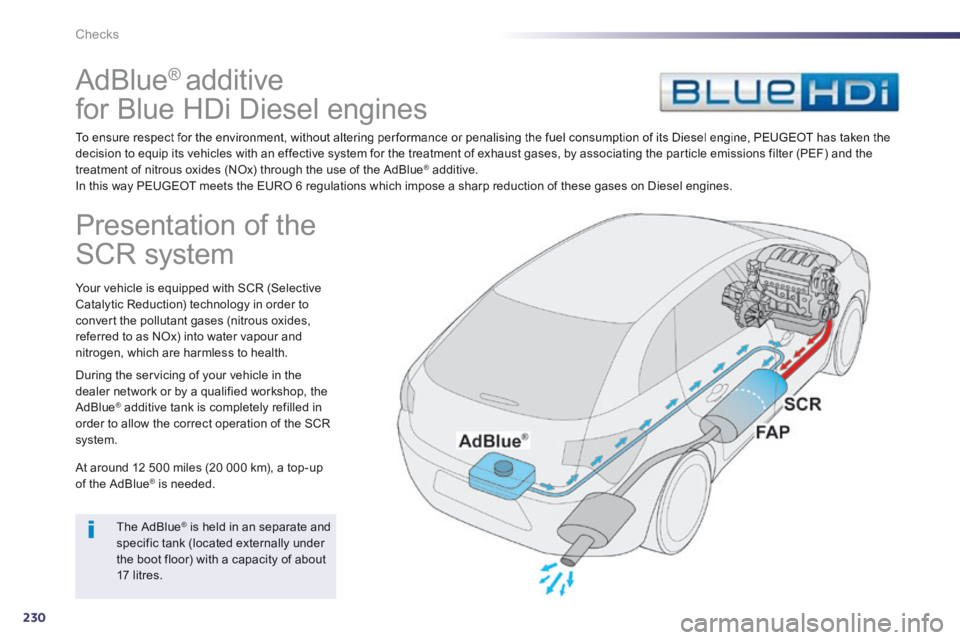
230
Checks
AdBlue ® additive
for Blue HDi Diesel engines
To ensure respect for the environment, without altering per formance or penalising the fuel consumption of its Diesel engine, PEUGEOT has taken the decision to equip its vehicles with an effective system for the treatment of exhaust gases, by associating the particle emissions filter (PEF) and the treatment of nitrous oxides (NOx) through the use of the AdBlue ® additive. ® additive. ®
In this way PEUGEOT meets the EURO 6 regulations which impose a sharp reduction of these gases on Diesel engines.
Presentation of the
SCR system
Your vehicle is equipped with SCR (Selective Catalytic Reduction) technology in order to convert the pollutant gases (nitrous oxides, referred to as NOx) into water vapour and nitrogen, which are harmless to health.
During the servicing of your vehicle in the dealer network or by a qualified workshop, the AdBlue ® additive tank is completely refilled in ® additive tank is completely refilled in ®
order to allow the correct operation of the SCR system.
At around 12 500 miles (20 000 km), a top-up of the AdBlue ® is needed. ® is needed. ®
The AdBlue ® is held in an separate and ® is held in an separate and ®
specific tank (located externally under the boot floor) with a capacity of about 17 litres.
Page 233 of 352
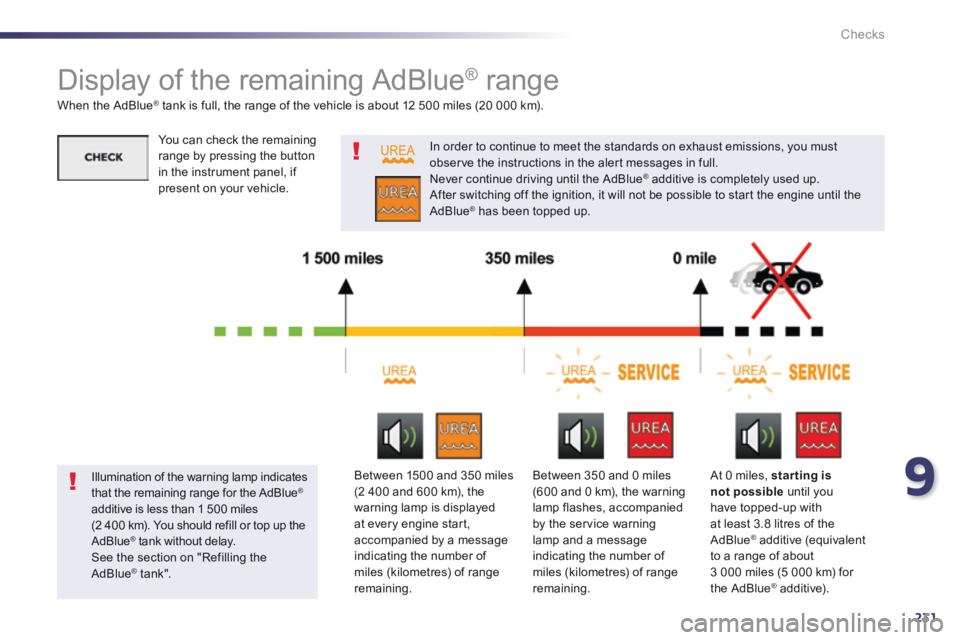
9
231
Checks
Display of the remaining AdBlue ® range
When the AdBlue ® tank is full, the range of the vehicle is about 12 500 miles (20 000 km). ® tank is full, the range of the vehicle is about 12 500 miles (20 000 km). ®
In order to continue to meet the standards on exhaust emissions, you must observe the instructions in the alert messages in full. Never continue driving until the AdBlue ® additive is completely used up. ® additive is completely used up. ®
After switching off the ignition, it will not be possible to start the engine until the AdBlue ® has been topped up. ® has been topped up. ®
Illumination of the warning lamp indicates that the remaining range for the AdBlue ® additive is less than 1 500 miles (2 400 km). You should refill or top up the
AdBlue ® tank without delay. ® tank without delay. ®
See the section on "Refilling the AdBlue ® t ank ". ® t ank ". ®
Between 1500 and 350 miles (2 400 and 600 km), the warning lamp is displayed at every engine start, accompanied by a message indicating the number of miles (kilometres) of range remaining.
Between 350 and 0 miles (600 and 0 km), the warning lamp flashes, accompanied by the service warning lamp and a message indicating the number of miles (kilometres) of range remaining.
At 0 miles, star ting is not possible until you have topped-up with at least 3.8 litres of the AdBlue ® additive (equivalent ® additive (equivalent ®
to a range of about 3 000 miles (5 000 km) for the AdBlue ® additive). ® additive). ®
You can check the remaining range by pressing the button in the instrument panel, if present on your vehicle.
Page 234 of 352
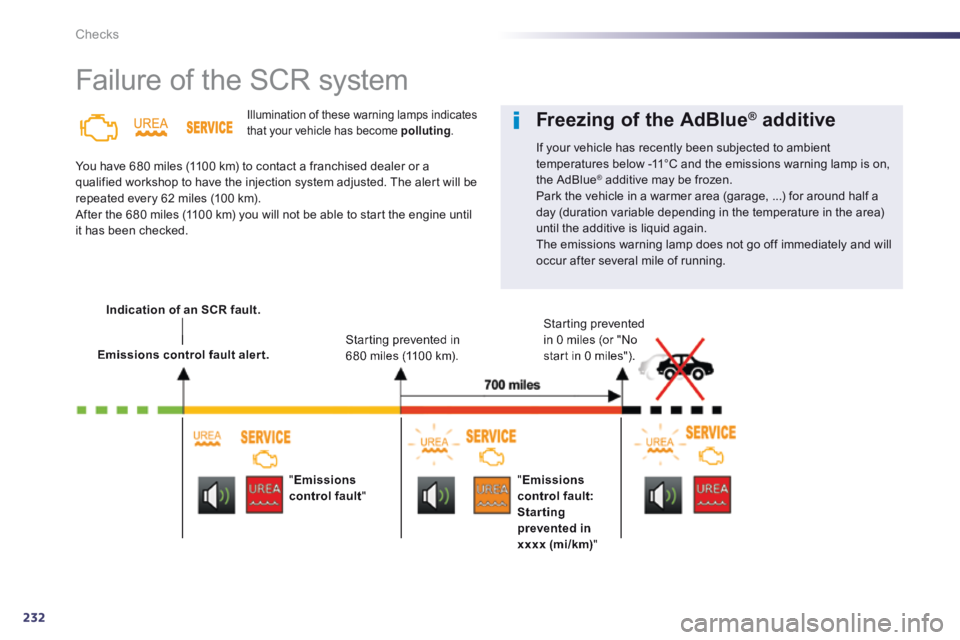
232
Checks
Failure of the SCR system
Illumination of these warning lamps indicates that your vehicle has become polluting .
You have 680 miles (1100 km) to contact a franchised dealer or a qualified workshop to have the injection system adjusted. The alert will be repeated every 62 miles (100 km). After the 680 miles (1100 km) you will not be able to start the engine until
it has been checked.
Indication of an SCR fault.
Emissions control fault alert. Starting prevented in Starting prevented in 680 miles (1100 km).
Starting prevented in 0 miles (or "No in 0 miles (or "No start in 0 miles").
" Emissions control fault " " Emissions control fault: Starting prevented in xxxx (mi/km) "
Freezing of the AdBlue ®Freezing of the AdBlue ®Freezing of the AdBlue additive ® additive ®
If your vehicle has recently been subjected to ambient temperatures below -11°C and the emissions warning lamp is on, the AdBlue ® additive may be frozen. ® additive may be frozen. ®
Park the vehicle in a warmer area (garage, ...) for around half a day (duration variable depending in the temperature in the area)
until the additive is liquid again. The emissions warning lamp does not go off immediately and will occur after several mile of running.
Page 235 of 352
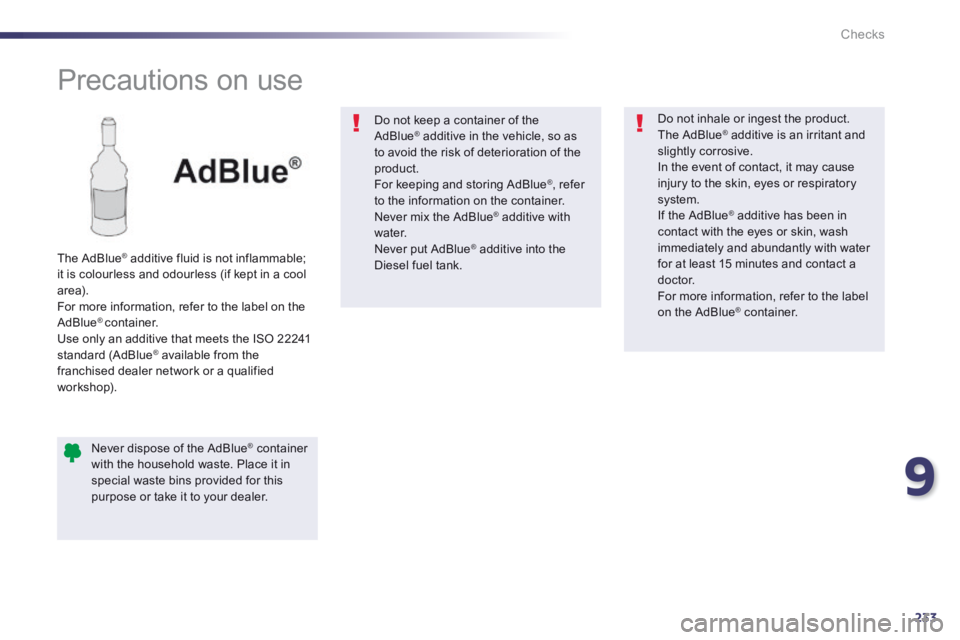
9
233
Checks
Precautions on use
The AdBlue ® additive fluid is not inflammable; ® additive fluid is not inflammable; ®
it is colourless and odourless (if kept in a cool area). For more information, refer to the label on the AdBlue ® c o n t a i n e r. Use only an additive that meets the ISO 22241 standard (AdBlue ® available from the ® available from the ®
franchised dealer network or a qualified wo r ks h o p).
Never dispose of the AdBlue ® container ® container ®
with the household waste. Place it in special waste bins provided for this purpose or take it to your dealer.
Do not keep a container of the AdBlue ® additive in the vehicle, so as ® additive in the vehicle, so as ®
to avoid the risk of deterioration of the product. For keeping and storing AdBlue ® , refer to the information on the container. Never mix the AdBlue ® additive with ® additive with ®
water. Never put AdBlue ® additive into the ® additive into the ®
Diesel fuel tank.
Do not inhale or ingest the product. The AdBlue ® additive is an irritant and ® additive is an irritant and ®
slightly corrosive. In the event of contact, it may cause injury to the skin, eyes or respiratory system. If the AdBlue ® additive has been in ® additive has been in ®
contact with the eyes or skin, wash immediately and abundantly with water for at least 15 minutes and contact a d o c t o r. For more information, refer to the label on the AdBlue ® c o n t a i n e r. ® c o n t a i n e r. ®
Page 236 of 352
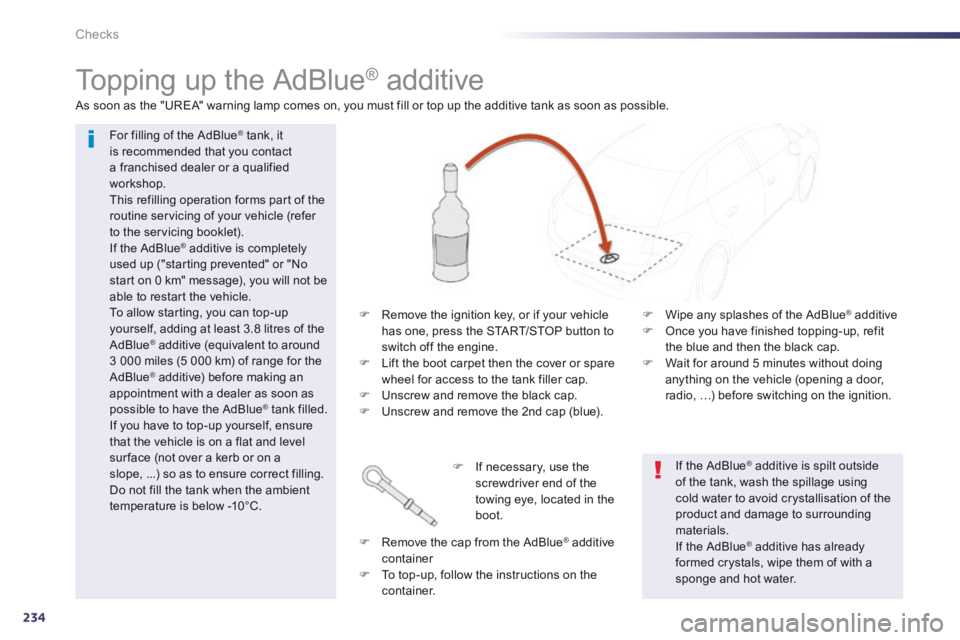
234
Checks
Topping up the AdBlue ® additive
For filling of the AdBlue ® tank, it ® tank, it ®
is recommended that you contact a franchised dealer or a qualified workshop. This refilling operation forms part of the routine servicing of your vehicle (refer to the servicing booklet). If the AdBlue ® additive is completely ® additive is completely ®
used up ("starting prevented" or "No start on 0 km" message), you will not be able to restart the vehicle. To allow starting, you can top-up yourself, adding at least 3.8 litres of the AdBlue ® additive (equivalent to around ® additive (equivalent to around ®
3 000 miles (5 000 km) of range for the AdBlue ® additive) before making an ® additive) before making an ®
appointment with a dealer as soon as possible to have the AdBlue ® tank filled. ® tank filled. ®
If you have to top-up yourself, ensure that the vehicle is on a flat and level sur face (not over a kerb or on a slope, ...) so as to ensure correct filling. Do not fill the tank when the ambient temperature is below -10°C.
As soon as the "UREA" warning lamp comes on, you must fill or top up the additive tank as soon as possible.
Remove the ignition key, or if your vehicle has one, press the START/STOP button to switch off the engine. Lift the boot carpet then the cover or spare wheel for access to the tank filler cap. Unscrew and remove the black cap. Unscrew and remove the 2nd cap (blue).
If necessary, use the screwdriver end of the towing eye, located in the boot.
Remove the cap from the AdBlue ® additive ® additive ®
container To top-up, follow the instructions on the
c o n t a i n e r.
If the AdBlue ® additive is spilt outside ® additive is spilt outside ®
of the tank, wash the spillage using cold water to avoid crystallisation of the product and damage to surrounding materials.
If the AdBlue ® additive has already ® additive has already ®
formed crystals, wipe them of with a sponge and hot water.
Wipe any splashes of the AdBlue ® additive ® additive ®
Once you have finished topping-up, refit the blue and then the black cap. Wait for around 5 minutes without doing anything on the vehicle (opening a door, radio, …) before switching on the ignition.
Page 243 of 352
10
241
Technical data
Blue HDi Diesel engines and gearboxes
Diesel engine2.0 litre Blue HDi 1502.0 litre Blue HDi 180
Gearbox Manual (6-speed) Automatic (6-speed)
Model code 8DAHXM/S 8EAHXM/S 8DAHWT/S 8 E A HW T/S
Body Saloon SW Saloon SW
Cubic capacity (cc) 1 997 1 997
Bore x stroke (mm) 85 x 88 85 x 88
Max power: EU standard (kW) 11 0 13 3
Max power engine speed (rpm) 4 000 3 750
Max torque: EU standard (Nm) 370 400
Max torque engine speed (rpm) 2 000 2 000
Fuel Diesel Diesel
Catalytic converter yes yes
Particle emissions filter yes yes
Oil capacity (in litres)
Engine (with filter replacement) - -
Page 247 of 352
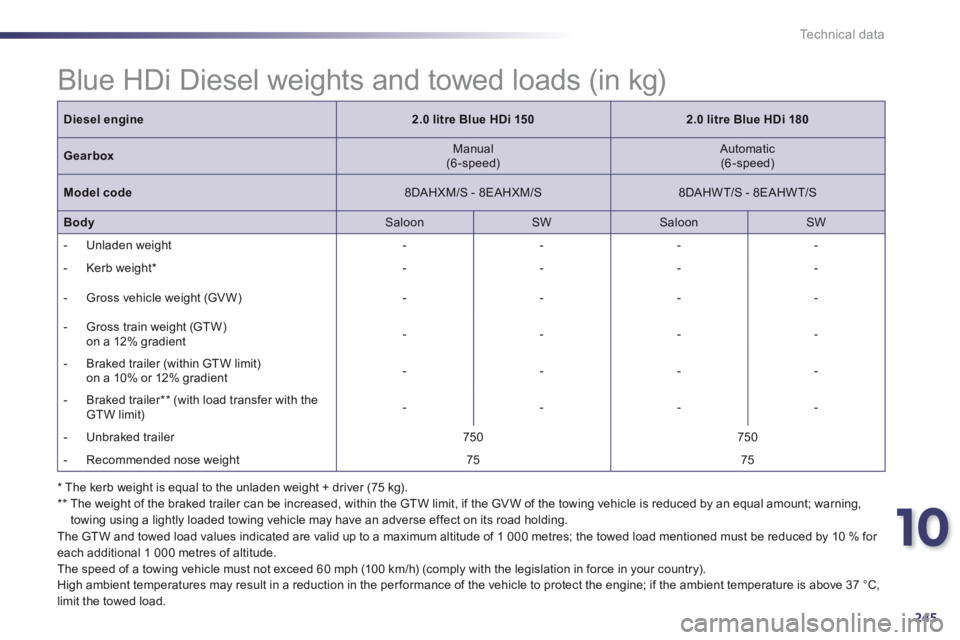
10
245
Technical data
Blue HDi Diesel weights and towed loads (in kg)
* The kerb weight is equal to the unladen weight + driver (75 kg). ** The weight of the braked trailer can be increased, within the GTW limit, if the GV W of the towing vehicle is reduced by an equal amount; warning, towing using a lightly loaded towing vehicle may have an adverse effect on its road holding.
The GTW and towed load values indicated are valid up to a maximum altitude of 1 000 metres; the towed load mentioned must be reduced by 10 % for each additional 1 000 metres of altitude. The speed of a towing vehicle must not exceed 60 mph (100 km/h) (comply with the legislation in force in your country).
High ambient temperatures may result in a reduction in the per formance of the vehicle to protect the engine; if the ambient temperature is above 37 °C, limit the towed load.
Diesel engine2.0 litre Blue HDi 1502.0 litre Blue HDi 180
Gearbox Manual (6-speed) Automatic (6-speed)
Model code 8DAHXM/S - 8EAHXM/S 8DAHWT/S - 8EAHWT/S
Body Saloon SW Saloon SW
- Unladen weight - - - -
- Kerb weight * - - - -
- Gross vehicle weight (GV W) - - - -
- Gross train weight (GTW) on a 12% gradient - - - -
- Braked trailer (within GTW limit) on a 10% or 12% gradient - - - -
- Braked trailer ** (with load transfer with the GTW limit) - - - -
- Unbraked trailer 750 750
- Recommended nose weight 75 75